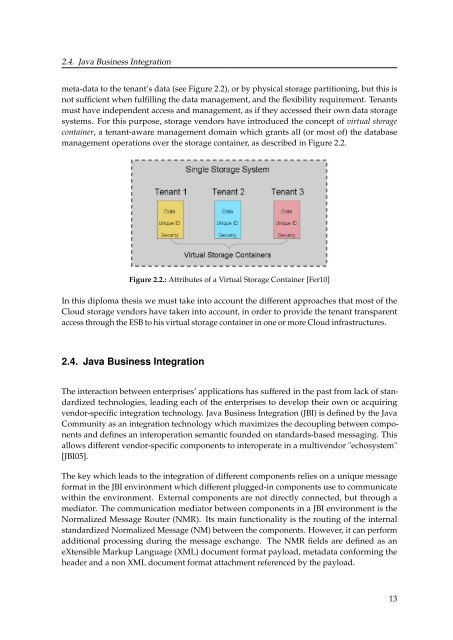Diploma Thesis Santiago Gómez Sáez - IAAS
Diploma Thesis Santiago Gómez Sáez - IAAS
Diploma Thesis Santiago Gómez Sáez - IAAS
You also want an ePaper? Increase the reach of your titles
YUMPU automatically turns print PDFs into web optimized ePapers that Google loves.
2.4. Java Business Integration<br />
meta-data to the tenant’s data (see Figure 2.2), or by physical storage partitioning, but this is<br />
not sufficient when fulfilling the data management, and the flexibility requirement. Tenants<br />
must have independent access and management, as if they accessed their own data storage<br />
systems. For this purpose, storage vendors have introduced the concept of virtual storage<br />
container, a tenant-aware management domain which grants all (or most of) the database<br />
management operations over the storage container, as described in Figure 2.2.<br />
Figure 2.2.: Attributes of a Virtual Storage Container [Fer10]<br />
In this diploma thesis we must take into account the different approaches that most of the<br />
Cloud storage vendors have taken into account, in order to provide the tenant transparent<br />
access through the ESB to his virtual storage container in one or more Cloud infrastructures.<br />
2.4. Java Business Integration<br />
The interaction between enterprises’ applications has suffered in the past from lack of standardized<br />
technologies, leading each of the enterprises to develop their own or acquiring<br />
vendor-specific integration technology. Java Business Integration (JBI) is defined by the Java<br />
Community as an integration technology which maximizes the decoupling between components<br />
and defines an interoperation semantic founded on standards-based messaging. This<br />
allows different vendor-specific components to interoperate in a multivendor "echosystem"<br />
[JBI05].<br />
The key which leads to the integration of different components relies on a unique message<br />
format in the JBI environment which different plugged-in components use to communicate<br />
within the environment. External components are not directly connected, but through a<br />
mediator. The communication mediator between components in a JBI environment is the<br />
Normalized Message Router (NMR). Its main functionality is the routing of the internal<br />
standardized Normalized Message (NM) between the components. However, it can perform<br />
additional processing during the message exchange. The NMR fields are defined as an<br />
eXtensible Markup Language (XML) document format payload, metadata conforming the<br />
header and a non XML document format attachment referenced by the payload.<br />
13

















